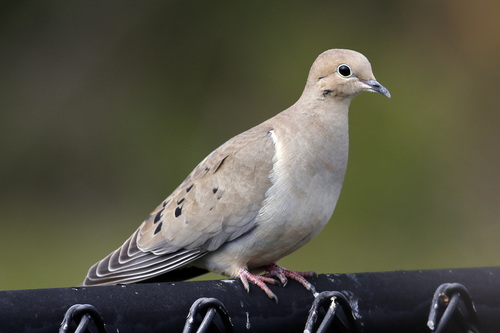
Mourning Dove
The Mourning Dove (Zenaida macroura) is a widespread and adaptable bird found throughout North America. It is recognized by its soft, mournful cooing call, which gives it its common name. Ecologically, Mourning Doves play a significant role as seed dispersers, contributing to plant diversity. They are also a popular game bird in many regions. Culturally, the Mourning Dove is sometimes associated with peace and tranquility, appearing in art and folklore.
22-36 cm
Length
37-45 cm
Wingspan
Least Concern
Conservation Status
Distribution
The Mourning Dove's range extends from southern Canada to central Mexico, and across the entire continental United States. Some populations are migratory, with northern birds moving south for the winter, while others are resident year-round. They are found in altitudinal ranges, from sea level to around 3000m.
Lifespan
Average lifespan in the wild is 1-1.5 years, though some individuals can live much longer (up to 19 years in captivity).
Mourning Dove's Habitat
Habitat Types
Open woodlands, Grasslands, Agricultural fields, Urban and suburban areas, Deserts, Forest edges
Climate Zones
Temperate, Subtropical, Arid
Adaptations
Mourning Doves are highly adaptable to various habitats, thriving in both natural and human-altered landscapes. Their ability to consume a wide variety of seeds allows them to survive in different environments.
Variations
Several subspecies are recognized, differing slightly in size and coloration. For example, the Western Mourning Dove (Z. m. marginella) tends to be paler than the Eastern Mourning Dove (Z. m. carolinensis).
Appearance
Breeding Plumage
Plumage is generally consistent year-round.
Seasonal Feather Changes
No significant seasonal variations.
Sex Based Plumage Differences
Males have a more pronounced rosy-pink wash on the breast and a blue-gray crown, while females are generally browner.
Notable Features
Slender body with a long, pointed tail., Small head relative to body size., Black spots on the wings., Pinkish legs and feet.
Diet and Feeding
Primary Foods
Seeds, Grains, Occasionally small insects and snails
Foraging Behavior
Mourning Doves primarily forage on the ground, picking up seeds and grains. They often feed in open areas and along roadsides.
Specializations
They have a crop, an enlarged part of the esophagus, where they can store seeds before digesting them. This allows them to gather food quickly in exposed areas and digest it later in a safer location.
Seasonal Diet Variations
Diet remains largely seed-based year-round, but the specific types of seeds consumed may vary depending on availability.
Behavior
Social Structure
Mourning Doves are often seen in pairs or small flocks, but can form larger flocks outside of the breeding season, especially at feeding sites.
Communication
Distinctive mournful cooing call ('ooOOO-woo-woo-woooo')., Wing whistles produced during takeoff and landing, possibly for alarm or communication.
Migration
Many northern populations migrate south for the winter, while others are resident. Migration is often triggered by cold weather and food scarcity.
Territorial or Group Behaviors
During the breeding season, males defend small territories around their nest sites. Outside of breeding, they are generally non-territorial.
Conservation
Threats
Habitat loss due to agriculture and urbanization., Lead poisoning from ingestion of spent lead shot., Collisions with vehicles and structures.
Protection Programs
Migratory Bird Treaty Act protection in the United States., Habitat restoration and management efforts in some areas.
Local National Laws
Protected under the Migratory Bird Treaty Act in the US, Canada, and Mexico.
Population Trend
Stable
Population Estimates
Estimated global population of around 475 million.
Interesting Facts
Mourning Doves can drink brackish water.
They have a higher tolerance for salt than many other birds, allowing them to utilize water sources unavailable to some species.
They are one of the most abundant and widespread birds in North America.
Their adaptability to various habitats and high reproductive rate contribute to their large population size.
Mourning Doves can produce multiple broods in a single breeding season.
In favorable conditions, they may raise up to six broods per year.
Faqs about Mourning Dove
What is the difference between a Mourning Dove and a pigeon?
Mourning Doves are generally smaller and more slender than Rock Pigeons (the common city pigeon), with a longer, pointed tail. Their coloration is also different, with Mourning Doves being predominantly brown and gray.
Why do I hear Mourning Doves cooing all the time?
The cooing call is primarily used by males to attract mates and defend territories, especially during the breeding season.
What should I do if I find a baby Mourning Dove?
If the bird appears healthy and is fully feathered, it is likely a fledgling and is best left alone. The parents are likely nearby. If it is injured or clearly orphaned, contact a local wildlife rehabilitator. *Consult a professional for expert advice.*
Are Mourning Doves hunted?
Yes, Mourning Doves are a popular game bird in many parts of the United States and are subject to regulated hunting seasons.
Copyright @ Nature Style Limited. All Rights Reserved.
 English
English